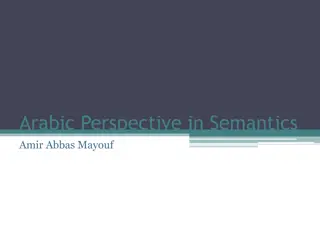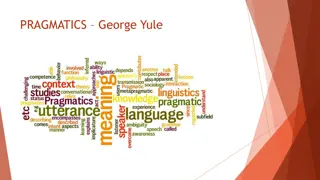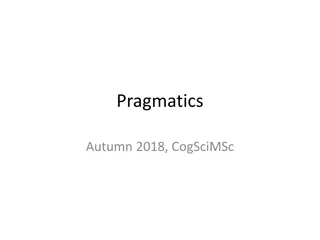An Exploration of Semantics and Pragmatics: Classical vs. Prototype Approach
Delve into the world of semantics and pragmatics through an examination of the classical and prototype approaches to defining categories. From Aristotle's sharp boundaries to Rosch's fuzzy categories, uncover the complexities and limitations of language structure and meaning.
Download Presentation

Please find below an Image/Link to download the presentation.
The content on the website is provided AS IS for your information and personal use only. It may not be sold, licensed, or shared on other websites without obtaining consent from the author.If you encounter any issues during the download, it is possible that the publisher has removed the file from their server.
You are allowed to download the files provided on this website for personal or commercial use, subject to the condition that they are used lawfully. All files are the property of their respective owners.
The content on the website is provided AS IS for your information and personal use only. It may not be sold, licensed, or shared on other websites without obtaining consent from the author.
E N D
Presentation Transcript
Chapter 7 Part II Introduction to Semantics & Pragmatics
Outline 7.2.1 The classical approach 7.2.2 Some problems of the classical approach 7.2.2.1 Lack of plausible analyses 7.2.2.2 Fuzzy boundaries 7.2.2.3 Internal structure of categories 7.2.3 The standard prototype approach Characteristics of Conceptual Categories within Rosch s Model 7.2.3.1 GOE and family resemblance 7.2.3.3 Intuitive unity, definitional polyvalence 7.2.3.4 Fuzzy boundaries 7.2.3.5 The mental representation of categories 7.2.3.6 Basic-level categories 7.3 Domains
7.2.1 The classical approach By Aristotle defines a category in terms of a set of necessary and sufficient criteria. for instance, the criteria for some X to qualify for inclusion in the category GIRL are: X is human X is female X is young
7.2.2 Some problems of the classical approach 7.2.2.1 Lack of plausible analyses The words like girl, which apparently can be defined by means of a set of necessary and sufficient features are small proportion of the vocabulary at large, and are confined to certain semantic areas, such as kinship, and specialized terms for animals specifying age and sex, and so on.
Wittgenstein's famous example is game. Its meaning cannot be captured by necessary and sufficient semantic features. One might suggest the following as possible criteria: (i) involves winning and losing: (ii) involves more than one person: (iii) has arbitrary rules: (iv) done purely for enjoyment:
7.2.2 Some problems of the classical approach 7.2.2.2 Fuzzy boundaries An Aristotelian definition of a category implies a sharp, fixed boundary. However, much empirical research on category structure has shown that the boundaries of natural categories are fuzzy. Example Judgments on the color seen by two people
7.2.2 Some problems of the classical approach 7.2.2.3 Internal structure of categories As far as the classical conception of categories goes, everything that satisfies the criteria has the same status, that is to say, something is either in the category, or not in it, and that is all there is to say about the matter.
However, language users feel that some members are felt to be 'better' examples of the category than others. For instance, an apple is a better example of a fruit than is a date, or an olive. In other words, categories have internal structure: there are central members, less central members, and borderline cases
7.2.3 The standard prototype approach The 'standard' approach to prototype theory, (Eleanor Rosch, 1973, 1978). The main thrust of Rosch's work has been to argue that natural conceptual categories are structured around the 'best' examples, or prototypes of the categories. Other items are assimilated to a category according to whether they sufficiently resemble the prototype or not.
Eleanor Rosch Professor Rosch is known for her work in concepts and categorization in cognitive psychology which has been influential in many fields (one of which is prototype theory in linguistics) and for her more recent work on Eastern psychologies and the psychology of religion. - See more at: http://psychology.berkeley.ed u/people/eleanor-h- rosch#sthash.hf4Q0rE2.dpuf
Characteristics of Conceptual Categories within Rosch s Model 7.2.3.1 GOE and family resemblance Rosch s Goodness-of-Exemplar (GOE) ratings. Subjects are asked to give a numerical value to their estimate of how good an example something is of a given category. So, for instance, if the category was VEGETABLE, the ratings of various items might be as follows: POTATO, CARROT I TURNIP, CABBAGE 2 CELERY, BEETROOT 3 AUBERGINE, COURGETTE 4 PARSLEY, BASIL 5 RHUBARB 6 LEMON 7
7.2.3.1 GOE and family resemblance Ratings of GOE may be strongly culture dependent. For instance, in a British context (say, a typical class of undergraduates), DATE typically receives a GOE score of 3-5 relative to the category of FRUIT, but an audience of Jordanians accorded it an almost unanimous 1
7.2.3.1 GOE and family resemblance Wittgenstein described the instances of the category GAME as manifesting a relationship of family resemblance: Prototype theory embraces Wittgenstein's notion that family resemblance unites the members of a category, but adds to it the vital idea of central and peripheral members.
Characteristics of Conceptual Categories within Rosch s Model 7.2.3.3 Intuitive unity, definitional polyvalence A purely linguistic characterization of categories with a prototypic organization is that they show intuitive unity, but are definitionally polyvalent. They cannot be captured by means of a single definition, but require a set of definitions
Characteristics of Conceptual Categories within Rosch s Model 7.2.3.4 Fuzzy boundaries A common position is to maintain that only the prototype has 100 per cent membership of a category, the degree of membership of other items being dependent on their degree of resemblance to the prototype, this, in turn, being reflected by their GOE score. From this one would have to conclude that a natural category has no real boundaries.
Characteristics of Conceptual Categories within Rosch s Model 7.2.3.5 The mental representation of categories The earliest hypotheses regarding the mental representation of categories suggested that there was some sort of portrait of the prototypical member, against which the similarity of other items could be computed and their status in the category determined. However, many prototype theorists (e.g. Lakoff) speak only of 'prototype effects', and remain uncommitted on the subject of the form of mental representations (Criticism).
7.2.3.6 Basic-level categories Categories occur at different levels of inclusiveness. (a) vehicle car hatchback. (b) fruit apple Granny Smith. (c) living thing creature animal cat Manx cat. (d) object implement cutlery spoon teaspoon. One level of specificity in each set has a special status (shown in bold in (2)), called basic or generic level of specificity.
Characteristics of basic-level items are as follows. (i) The most inclusive level at which there are characteristic patterns of behavioural interaction. (ii) The most inclusive level for which a clear visual image can be formed. (iii) Used for neutral, everyday reference. Often felt by speakers to be the 'real' name of the referent.
Characteristics of basic-level items are as follows. (iv) The basic level is the level at which the best categories can be created. Good categories are those which maximize the following characteristics: (a) distinctness from neighbouring categories; (b) internal homogeneity;
Characteristics of basic-level items are as follows. (v) Names of basic level categories tend to be morphologically simple. Take the case of spoon, which is a basic-level term; all the more specific categories have more complex names: teaspoon, tablespoon, soup spoon, coffee spoon, etc.
7.3 Domains An important aspect of conceptual structure is emphasized by Langacker and his followers, and that is that concepts only make sense when viewed against the background of certain domains, which are usually themselves concepts of a more general or inclusive nature.
7.3 Domains Langacker refers to the region or aspect of a domain highlighted by a concept as the profile, and the domain part is called the base; thus, WHEEL profiles a region of the base BICYCLE. It is important to note that profile and base are relational terms, not absolute ones.























